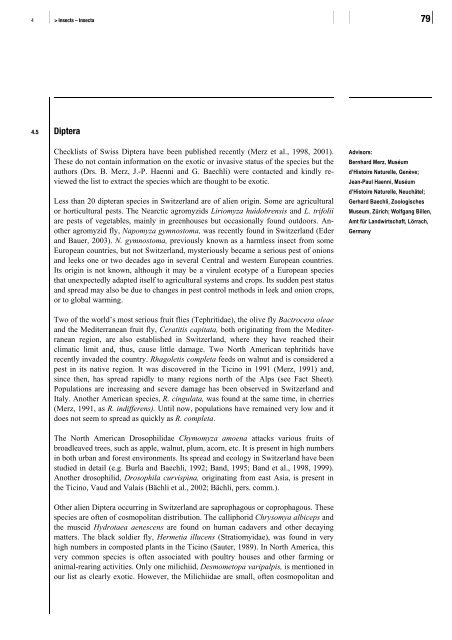Invasive alien species in Switzerland - Schweizer ...
Invasive alien species in Switzerland - Schweizer ...
Invasive alien species in Switzerland - Schweizer ...
Create successful ePaper yourself
Turn your PDF publications into a flip-book with our unique Google optimized e-Paper software.
4 > Insects – Insecta 79<br />
4.5 Diptera<br />
Checklists of Swiss Diptera have been published recently (Merz et al., 1998, 2001).<br />
These do not conta<strong>in</strong> <strong>in</strong>formation on the exotic or <strong>in</strong>vasive status of the <strong>species</strong> but the<br />
authors (Drs. B. Merz, J.-P. Haenni and G. Baechli) were contacted and k<strong>in</strong>dly reviewed<br />
the list to extract the <strong>species</strong> which are thought to be exotic.<br />
Less than 20 dipteran <strong>species</strong> <strong>in</strong> <strong>Switzerland</strong> are of <strong>alien</strong> orig<strong>in</strong>. Some are agricultural<br />
or horticultural pests. The Nearctic agromyzids Liriomyza huidobrensis and L. trifolii<br />
are pests of vegetables, ma<strong>in</strong>ly <strong>in</strong> greenhouses but occasionally found outdoors. Another<br />
agromyzid fly, Napomyza gymnostoma, was recently found <strong>in</strong> <strong>Switzerland</strong> (Eder<br />
and Bauer, 2003). N. gymnostoma, previously known as a harmless <strong>in</strong>sect from some<br />
European countries, but not <strong>Switzerland</strong>, mysteriously became a serious pest of onions<br />
and leeks one or two decades ago <strong>in</strong> several Central and western European countries.<br />
Its orig<strong>in</strong> is not known, although it may be a virulent ecotype of a European <strong>species</strong><br />
that unexpectedly adapted itself to agricultural systems and crops. Its sudden pest status<br />
and spread may also be due to changes <strong>in</strong> pest control methods <strong>in</strong> leek and onion crops,<br />
or to global warm<strong>in</strong>g.<br />
Two of the world’s most serious fruit flies (Tephritidae), the olive fly Bactrocera oleae<br />
and the Mediterranean fruit fly, Ceratitis capitata, both orig<strong>in</strong>at<strong>in</strong>g from the Mediterranean<br />
region, are also established <strong>in</strong> <strong>Switzerland</strong>, where they have reached their<br />
climatic limit and, thus, cause little damage. Two North American tephritids have<br />
recently <strong>in</strong>vaded the country. Rhagoletis completa feeds on walnut and is considered a<br />
pest <strong>in</strong> its native region. It was discovered <strong>in</strong> the Tic<strong>in</strong>o <strong>in</strong> 1991 (Merz, 1991) and,<br />
s<strong>in</strong>ce then, has spread rapidly to many regions north of the Alps (see Fact Sheet).<br />
Populations are <strong>in</strong>creas<strong>in</strong>g and severe damage has been observed <strong>in</strong> <strong>Switzerland</strong> and<br />
Italy. Another American <strong>species</strong>, R. c<strong>in</strong>gulata, was found at the same time, <strong>in</strong> cherries<br />
(Merz, 1991, as R. <strong>in</strong>differens). Until now, populations have rema<strong>in</strong>ed very low and it<br />
does not seem to spread as quickly as R. completa.<br />
The North American Drosophilidae Chymomyza amoena attacks various fruits of<br />
broadleaved trees, such as apple, walnut, plum, acorn, etc. It is present <strong>in</strong> high numbers<br />
<strong>in</strong> both urban and forest environments. Its spread and ecology <strong>in</strong> <strong>Switzerland</strong> have been<br />
studied <strong>in</strong> detail (e.g. Burla and Baechli, 1992; Band, 1995; Band et al., 1998, 1999).<br />
Another drosophilid, Drosophila curvisp<strong>in</strong>a, orig<strong>in</strong>at<strong>in</strong>g from east Asia, is present <strong>in</strong><br />
the Tic<strong>in</strong>o, Vaud and Valais (Bächli et al., 2002; Bächli, pers. comm.).<br />
Other <strong>alien</strong> Diptera occurr<strong>in</strong>g <strong>in</strong> <strong>Switzerland</strong> are saprophagous or coprophagous. These<br />
<strong>species</strong> are often of cosmopolitan distribution. The calliphorid Chrysomya albiceps and<br />
the muscid Hydrotaea aenescens are found on human cadavers and other decay<strong>in</strong>g<br />
matters. The black soldier fly, Hermetia illucens (Stratiomyidae), was found <strong>in</strong> very<br />
high numbers <strong>in</strong> composted plants <strong>in</strong> the Tic<strong>in</strong>o (Sauter, 1989). In North America, this<br />
very common <strong>species</strong> is often associated with poultry houses and other farm<strong>in</strong>g or<br />
animal-rear<strong>in</strong>g activities. Only one milichiid, Desmometopa varipalpis, is mentioned <strong>in</strong><br />
our list as clearly exotic. However, the Milichiidae are small, often cosmopolitan and<br />
Advisors:<br />
Bernhard Merz, Muséum<br />
d’Histoire Naturelle, Genève;<br />
Jean-Paul Haenni, Muséum<br />
d’Histoire Naturelle, Neuchâtel;<br />
Gerhard Baechli, Zoologisches<br />
Museum, Zürich; Wolfgang Billen,<br />
Amt für Landwirtschaft, Lörrach,<br />
Germany
















